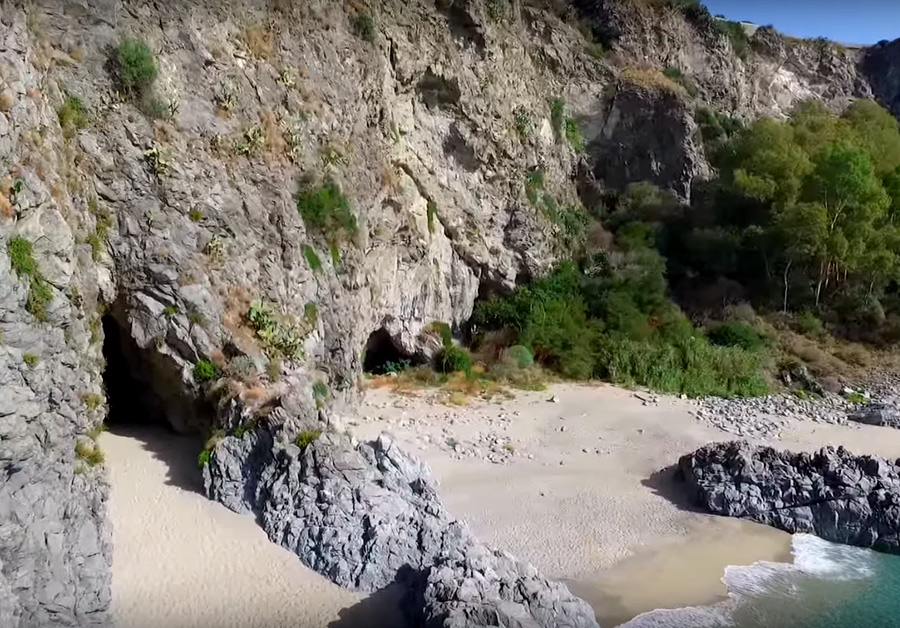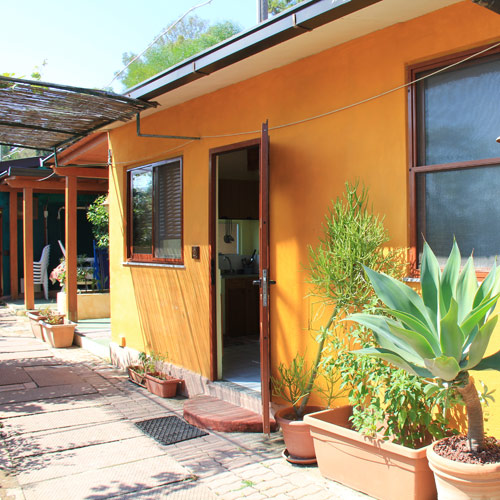The Beach of Caminia is part of the Municipality of Stalettì, in the province of Catanzaro, at about 2 Km from Catanzaro Lido, and 9 Km from the very famous sea town of Soverato.
It is easily reachable following the specific street sign: exit from the SS 106 and direction to Pietragrande.
Caminia, lying in the Jonic coastline called “the Saracens’ Coast”, it is one of the most beautiful beaches of the slope of the promontory of Copanello at the Gulf of Squillace. The clear and sandy beach, very sheltered and wide, is set among two panoramic bluffs that form a natural bay rich of caves, inlets and archaeological testimonies. The great success of Caminia not only derives from its natural beauty, but also (and above all) from its crystalline and transparent sea composed by a backdrop that quickly goes down toward the sea where, sometimes, it is possible to meet shoals of a pair of meters deep.
The very calm and transparent sea, together with the short depth and the surrounding bluffs and rich inlets, make this place the perfect destination for the lovers of the snorkeling and day or night immersions (average depth: 12mt).
Particularly interesting is the cave that is located on the left side of the coast. It is the beautiful cave in which, according to the tradition, the relics of St. Gregorio Taumaturgo have been deposited. The cave can be reached both going swimming or via a path long side the rock, usually used as springboard for dips in sea.
The whole cliff of Caminia is sprinkled of suggestive isolated places that can be reached on swimming or with by canoe.
Famous as few, the beach of Caminia possesses a disarming beauty. Who comes here for the first time is soon charmed by this gulf, the thousand tonalities of blue, its rocky walls and by the splendid Mediterranean vegetation. Caminia is a true heaven!
THE HISTORY
The history of Caminia is deeply tied to the ancient Greek colony of Skylletium, distant about 10 km, whose myth around its foundation goes back to the stories of the War of Troy and the founder Ulisse, who shipwrecked in this place, as pointed out by Strabone. Historically and actually, the foundation of Skylletion can be related, with high probability, to the colony of Kroton, which contended to the southern Locri Epizefiri the control on the actual piece of sea in front of Catanzaro and the maritime traffics in this coastal sector (where the actual Bay of Caminia is located today); originally, the center of Skylletium had the characteristic of military garrison since the first half of the VI century b.C.
During the IV century b.C. the whole area passes under the control of the Brettiis. It is a period of deep decadence up to the foundation of the new Roman colony by Gaio Sempronio Gracco: Scolacium, the Cassiodoro’s city, named also Scylletium. From this moment onward, in age Giulio-Claudia, the colony regains vitality and prosperity thanks to a phase of notable economic, urbanistic and architectural development, then turned into the new colony under Nerva (96-98), with the name of Colony August Minerva Nervia Scolacium.
With the following historical period in Byzantine age, news of the Senator Cassiodoro are found (487 -583). Born in this colony, he was one of the greatest authors of the late roman period, to whom a quantity of works of theological encyclopedic character and inestimable historical value are credited. The same archaeological area of Caminia is called today with the name of Cassiodorea, and the evidence of the ancient Vivarium (tubs for breeding fishes then taken up to to the monastery) are still well visible at little distance, near the cliff of Copanello.
The decline starts with the Greek-Gothic war of the VI century and the raids of the Saracens from 902 a.C, unfortunately. It ends with the abandonment of the city in the VIII century. The inhabitants, following a quite common Italic practice in that period, transfer their installations on the surrounding high hills, founding other installations of which that one overlooking the hill of the today district of Santa Maria of Catanzaro, that will contribute, among the other things, to the foundation of the new city of Catanzaro.
In the Byzantine period, it is Caminia to furnish a maritime landing service to the castrum, in the same place where today the rests of a tiny church (Panaja) are visible. The toponym of this place unequivocally points out a dedication to the Madonna, as it often happened in the region. Of Panaja today, it is still possible to observe a small apse directed to north-east planned on a previous wall of great thickness (1,50 mt) made of granites. The hypothesis is that this church belonged to the possessions of the monastery of St. Martin, donated by the Count Ruggero of Calabria and Sicily in the second half the XI century . The church of S. Maria of Panaja results listed on 1310 among the churches of the diocese.
With the advent of the Saracens and the Normans the whole coastline is subject to deep attacks and raids by sea; indeed, still today, it is in use the appellative of “the Saracens’ Coast.”
The whole coastline, in the following centuries, passes under the control of the different dominations that crossed the territory of southern Italy till the modern age. With the Second World War this geographical sector falls under sensitive military control because of its strategic position over the gulf. Bunkers are built, disseminated in the most panoramic points, of which today there is still evidence of one of them in the side of the Cliff of Copanello (coastal bunker with a gun of big caliber).
In the 60s Caminia passes from the forgetfulness to the attention of the inhabitants of the relative district of Stalettì, which began to use this slice of beach as “town reserved beach.” The construction of small shelters in the form of summer cabina have left the place to beach rental places and small tourist villages equipped for a modern national and international tourist receptiveness.














